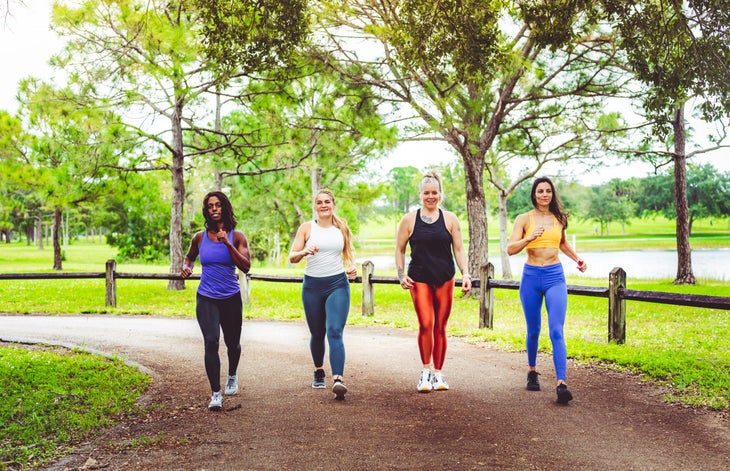Heading out the door? Read this article on the new Outside+ app available now on iOS devices for members! Download the app.
Rest is an important part of recovery, but just because you’ve finished a tough workout doesn’t mean it’s best to be idle. In fact, experts agree that gentle movement or light training to get your heart rate up on rest days, aka active recovery, can help move the blood around and help your body repair itself postworkout.
“Active recovery is the unsung hero when it comes to recovery,” says Elizabeth Andrews, ACSM-certified fitness instructor, presenter, educator and movement coach. “Walking, mobility drills and easier yoga classes are all ways to rest actively without over-stressing the body from training.”
The key is to keep your body moving but to not overload or overdo it. Your body is already taxed from your workout, and now it needs time to repair and regenerate. Too many hard workouts with too little rest in between will only increase risk of burnout and injury. But play your cards right, and you’ll likely see a boost in mobility along with less soreness.
Here are four different active recovery options to help you speed up your workout recovery.
4 Active Rest Strategies for Muscle Recovery
1. Walking. Assuming you’re a fitness junkie, walking might sound too easy. Despite the fact that it’s low impact and low intensity, walking is a total-body exercise if you get your arms involved. And yes, it’s a perfectly effective — not to mention accessible, since all you need is to step outside — rest-day activity.
“Whether it’s walking, hiking or biking, it’s allowing the muscles to continue to grow and get stronger,” says Nancy Jusino, PES, OES. Ankle circles, wrist circles, shoulder shrugs or seated marching are also solid options.

2. Gentle yoga. Dynamic stretching during an easy yoga flow promotes muscle recovery, according to recent research published in the International Journal of Human Movement and Sports Sciences. While it won’t reduce initial soreness, the gentle movement of a stretch will increase circulation and oxygen uptake — if you incorporate breathing techniques, that is. Simply put, deep breathing moves the blood around as oxygen is transported to all nooks and crannies of your body. Gentle yoga is effective at reducing muscle soreness postworkout particularly because it prioritizes deep breathing.
3. Active rest. Active rest includes pretty much anything that gets you moving without taxing your muscles. Activities like organizing your pantry, dusting your family room or even cleaning out your closet count. If those are the last tasks you’d ever want to tackle postworkout, try any activity that keeps you on your feet.
“Recovery will be faster with active rest,” says Jusino, because being completely stationary after a hard workout will only increase stiffness. Research published in the Journal of Sports Sciences says the intensity of your active rest matters, too, so keep it chill to reap benefits of recovery.
4. Cross-training. A paper published from Michigan State University lists cross-training as a useful tool for exercise recovery and for its injury-prevention benefits. The key is to make sure you’re working your muscles at a different angle or with a different load or technique. Doing so serves to move the blood around, flushing out your soreness in a sense, while not adding the same or additional stress or load on your muscles.
You’ll want to make sure that any cross-training you do is lower intensity, lower impact and shorter in duration than your previous workout. For example, if you logged a hard run, the next day head out for an easy spin on your bike. After putting in a high-intensity weight workout, an easy swim could be a great recovery activity.